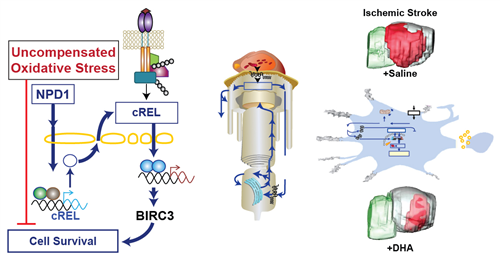
Gene-regulated neuroprotection disease-modifying mechanism for vision and stroke
Research led by Nicolas Bazan, MD, PhD, has discovered gene interactions that determine whether cells live or die in the retina and brain. They have uncovered a stereospecific mediator that targets gene interactions leading to cell survival relevant to retinal degenerative diseases, including age-related macular degeneration. Moreover, they also found that this key event halts progression of experimental ischemic stroke damage by activating a neuronal selective event. The molecular mechanisms identified seem to be critical for vision (RPE-photoreceptor cell) and brain integrity (selectively neuronal). The paper is published online in Cell Death & Differentiation, a Nature journal at http://www.nature.com/cdd/journal/vaop/ncurrent/full/cdd2014233a.aspx.
“Studying the responses of the eye and the brain that mimics the onset of homeostasis disruptions that might lead to disease hold a key to creating therapeutic solutions for blindness, stroke and other seemingly unrelated neurological and psychiatric conditions,” notes Dr. Bazan. “The eye is a window to the brain.”
Dr. Bazan and his colleagues discovered Neuroprotectin D1 (NPD1), which is made from the essential fatty acid, docosahexaenoic acid (DHA). Previous work showed that while it protected cells, the molecular principles underlying this protection were not known.
“We have uncovered a novel control that makes definitive decisions about whether a retina or brain cell will survive or die when threatened with disease onset. The gene mechanism that we discovered is the interplay of two genes turned on in a cascade fashion by the mediator Neuroprotectin D1,” said Dr. Bazan. “The protein cRel acts like an intracellular messenger of this lipid mediator.”
The research team worked with human RPE cells and with an experimental model of ischemic stroke. These novel mechanisms uncovered the ability of the mediator to activate pathways that crosstalk one to another and then assemble consolidated responses that decide cell fate. Thus the powerful messenger, NPD1, is produced on-demand in the brain and retina and elicits a network of positive signals essential for the well-being of vision and brain function.
